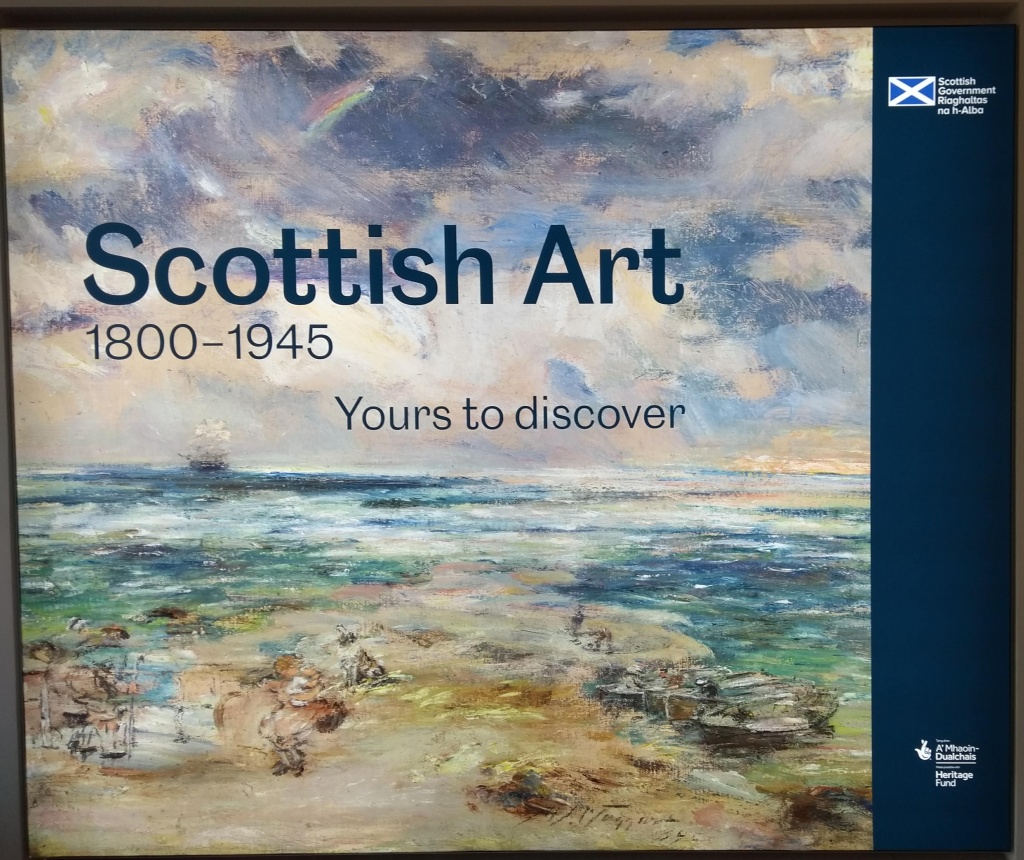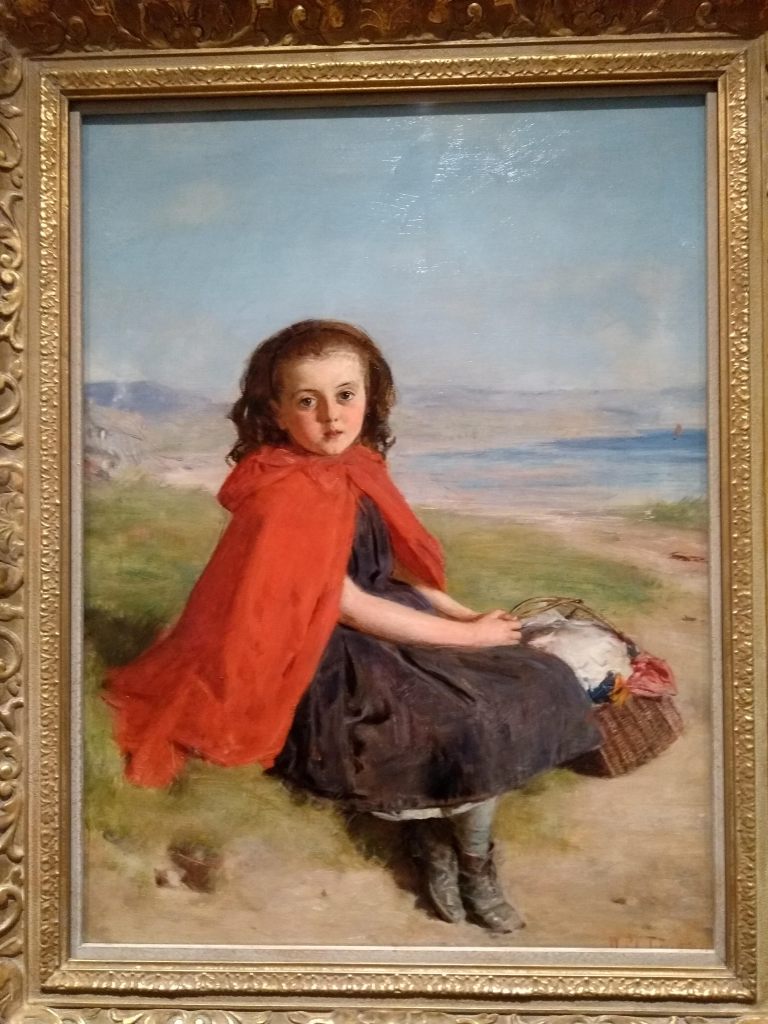
The new Scottish art section in the National Galleries opened in Edinburgh on 30 Sept and I’d been planning to go there ever since, particularly after reading two articles in The Guardian – a bit of a snidey one by Severin Carrell, their What’swrongwithScotland Editor, on 29 September and a surprisingly positive one from the normally-carnaptious Jonathan Jones, their art critic, four days previously.
Here are the links:
https://www.theguardian.com/uk-news/2023/sep/29/scotland-national-galleries-long-way-to-go-inclusive-outgoing-chief-john-leighton We can rely on Mr Carrell to find the negatives in any good news story that’s due to come out. I don’t think these galleries are alone in attracting a mainly middle class crowd and making all cultural institutions more inclusive is a long term goal and not an easy one to achieve.
https://www.theguardian.com/artanddesign/2023/sep/25/glasgow-to-the-rescue-blast-of-realism-gives-the-new-scottish-galleries-punch-review Mr Jones awards four stars out of five to the Scottish art display and its new accommodation. I’d have given 4.5 stars, the slight deduction is firstly for the prices in the restaurant which are certainly not conducive to Sir John Leighton’s inclusivity goal and secondly for the siting of the hand driers in the women’s toilets. I certainly agree with him that the new downstairs section of the building is lovely, full of light from the big windows which face east on to Princes Street Gardens.
I managed to go in the ‘wrong’ entrance, missing the information panel and the plan of the rooms displayed just inside the entrance nearer to Princes Street; I felt a bit confused at first so I’d recommend you do it the other way round. We’re told that when the National Galleries opened in 1859, there were “few Scottish works in the national collection” whereas now they have about 60,000 objects – the “largest and most significant collection of Scottish art in the world”. There will be “changing displays of drawings, watercolours, early photographs and prints”. The items on display “reflect the interests and concerns of past generations ….. (and) …. signal exciting possibilities for the future”. Fair enough, I thought.
Given that I’ve twice complained about the cleanliness of the stairs in the City Art Centre, (see Cauld kail het up), I took particular note of the design of the staircase here and its potential for trapping dirt and giving us all a showing up.

I enjoyed seeing some old favourites including William McTaggart’s dramatic seascapes, but also his “Halfway Home”, with the winsome lassie in her red cloak staring out at us as she takes rest with her basket on the edge of a path by the shore. The bay behind her may be Lochranza where the artist was working in 1866/67.

The one I like best of all though is Sir James Guthrie’s “A Hind’s Daughter” with another wee girl looking at us, taking momentary respite from her job of cutting sprouts in a field outside a cottage in Cockburnspath. It was painted in 1883 and a hind was a seasonal farm worker. There’s no red cloak for this lassie, just a rough-looking apron tied round her waist. This is one of the Glasgow Boys paintings much approved of by Jonathan Jones.

The Glasgow Girls also have a section, represented by Bessie MacNicol, Margaret and Frances Macdonald, and Flora Macdonald Reid who “painted contemporary subjects in a naturalistic style” and who “travelled independently to France and Belgium”. We’re told it was the work of the Boys that represented “the beginnings of modernism in Scottish art” as they “recorded contemporary rural life, often working out of doors”.
I was surprised to see Jules Bastien-Lepage’s “Pas Meche” on a wall, his painting of a barge boy, which I’m sure I’d seen before somewhere in Glasgow. It’s explained that it’s included to show his “important impact on the Glasgow Boys”. So many of the labels had foreign influences on the artists attributed which is fair enough where it’s important and has been established but it’s rankled with me before in other galleries: is this done for national art collections in other countries? On the other hand, I liked some of the comments from school pupils beside certain paintings which could be insightful or quite funny; many sounded natural but in others I could detect a response to a teacher’s plan. Hopefully being involved in such a project would encourage the bairns to come one day and see the paintings with their comments alongside or maybe the comments could be continually refreshed with the thoughts of the next group of children.
Phoebe Anna Traquair’s four embroidered panels “The Progress Of a Soul” are there in the Symbolism and the Celtic Revival section, together with “Angus Og” by John Duncan which was a new one on me, as was the contrasting “Avatar” by Henry Lintott which portrays, I think, a dead WW1 soldier covered in a black shroud being borne up into the sky by four white-robed figures. The information panel in this section gives credit to Patrick Geddes as an “inspirational thinker, biologist and utopian socialist”; turns out he was also a geographer, philanthropist, town planner and the author of the phrase “think global, act local”. So somebody well worth commemorating in his native Scotland but just how well remembered is he?
Some paintings have come from the Portrait Gallery: Raeburn’s “Alastair Macdonell of Glengarry” , a baddie who cleared tenants to make way for sheep farming, and two portraits by Allan Ramsay – “Katherine Hall of Dunglass” and the just lovely one of his second wife “Margaret Lindsay” in the act of flower arranging (I went on about her before in Recent Gallivanting).
I have no objections whatsoever to the many landscape paintings in the 1730 – 1930 bit. We’re told: “artists have helped to define the image of Scotland, making the landscape one of the most recognisable and enduring symbols of national identity”. There are lowland scenes as well as highland but it’s the latter that are memorable for me, “romanticised” as they are and with very few, if any, local folk in them. Horatio McCulloch’s work is here – “Inverlochy Castle” and “Highland landscape with a waterfall” – and so are the famous Scottish-set works of the English artist Edwin Landseer – “Monarch of the Glen” stands in all his glory next to the poor dead beastie in “Scene in the Highlands ….”; we’re told that the stag hunt was “then seen as a noble sport”.
A dying stag is right in the middle of Benjamin West’s “Alexander III of Scotland Rescued from the Fury of a Stag by the Intrepidity of Colin Fitzgerald”. This 1786 work has remained in its prime position right by the entrance to the main National Galleries upstairs and it’s one I’ve often stared at, given my Mackenzie connections.

I’m always intrigued by Fitzgerald’s choice of hunting outfit: a silky pink tunic and a pair of sandals. And it looks like it’s the dog that’s going to get in the fatal blow. Anyway, the grateful king rewarded his Irish rescuer by granting him the lands of Kintail where he’s reputed to have founded the clan Mackenzie. It was commissioned by Lord Seaforth “as a spectacular piece of dynastic propaganda and part of his campaign to restore the family fortunes compromised by the failed 1715 Jacobite rising”.
Also upstairs, unseen for the last five years, are “The murder of Rizzio” by Sir William Allan and nearby is Robert Hardman’s “Mary Queen of Scots: The Farewell to France” in which she’s right to be feeling wistful as her ship departs for Scotland. Here too are Sir George Harvey’s “A schule skailing” with the bairns jostling as they hurtle out the door and Sir David Wilkie’s wonderfully crowded “Pitlessie Fair” – we’re told that some of the figures he sketched secretly in the kirk. “Reverend Robert Walker skating on Duddingston Loch” is back, re-attributed by “majority opinion” to Sir Henry Raeburn after the stooshies of 2005 and 2013.
I could go on, but I won’t. I’m sorry my photos have come out a bit squinty so go and see them all for yourselves. Inevitably there’s a gift shop which on 10 November was in full Christmas mode. Yes, there are hairy blankets and heather tea but not all the products are couthie. There’s a full Monarch of the Glen display of mugs, bags, cards, socks etc and The Skating Minister also has his own product lines.

I hope you can read the menu above for the Contini restaurant and especially its prices. It was queued out the door so Mr Carrell’s middle classes must have been out in force. I was amused to see the porridge made with double cream and topped with caramelised banana, peanut butter and flaked almonds + an optional dram of Glengoyne as it outdoes even London’s Loka (see Cauld kail het up); we’ve come a long way from oatmeal, water and salt.
As a postscript to the above paragraph, My Favourite Niece went for breakfast on a Saturday in January and reported that she was the youngest person in the restaurant by about 45 years; she can be a wee tait prone to exaggeration so I’m knocking that down to 35 years with everybody else over 60. The others were mainly tourists she thought but there were a couple of tables of folk she took to be local regulars. She had the double cream porridge topped with blowtorched banana slices but turned down the peanut butter drizzle – the besom – although she enquired for me how it’d have been served. The large portion of porridge was not from a packet but properly made; however the severely under ripe bananas had a turnip texture and the double cream was coursing through her arteries for the next 24 hours. She’d recommend going for the oat milk version instead with seasonal berries and mint. The space was large and brightly decorated; she could see no visible stoor on the lights or exposed wires and the restaurant toilets had a dry floor. During her visit, I got two pictures, twenty one messages and a fifty one second voice mail so she fair fulfilled her spying mission and could well be re-hired in future.
On my visit, I paid £3 to take away a small bottle of Strathmore still water from the Espresso cafe just inside the entrance of the main building upstairs; I told the two staff members it was utterly ridiculous and exploitative but they just gawped at me. Don’t suppose it was them setting the prices though.
Finally to the flushings which I always like to review. The floor was marked with muddy footprints, caused I think by the siting of the hand driers round the corner from the washbasins; hands would be dripping as women searched for them. Jonathan Jones unfortunately had no comment to make on the cleanliness of the facilities for men.
